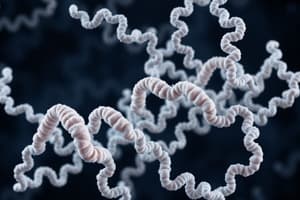Podcast
Questions and Answers
What is the primary function of enzymes in a cell?
What is the primary function of enzymes in a cell?
- Provide structure and support to cells
- Participate in metabolic pathways
- Control the expression of other genes
- Speed up biochemical reactions (correct)
Which type of proteins is crucial for maintaining the structure of bones and muscles?
Which type of proteins is crucial for maintaining the structure of bones and muscles?
- Transcription Factors
- Structural Proteins (correct)
- Regulatory Proteins
- Enzymes
What do regulatory proteins primarily control in a cell?
What do regulatory proteins primarily control in a cell?
- Cellular signals
- Biochemical reactions
- Gene expression (correct)
- Metabolic pathways
In what way do enzymes participate in different types of reactions?
In what way do enzymes participate in different types of reactions?
Which type of proteins act as catalysts in biochemical reactions?
Which type of proteins act as catalysts in biochemical reactions?
What is the main function of structural proteins in living organisms?
What is the main function of structural proteins in living organisms?
What are the building blocks of proteins?
What are the building blocks of proteins?
How are amino acids linked together in proteins?
How are amino acids linked together in proteins?
What is the primary structure of proteins?
What is the primary structure of proteins?
How are folded proteins stabilized?
How are folded proteins stabilized?
What process is involved in protein expression?
What process is involved in protein expression?
How do proteins interact with one another?
How do proteins interact with one another?
Flashcards are hidden until you start studying
Study Notes
Proteins: The Versatile Macromolecules
Proteins are organic molecules that play a pivotal role in living organisms, functioning as the building blocks of tissues and cells. They are composed of one or more long chains of amino acids, which are linked by peptide bonds. Proteins are among the most abundant organic molecules in living systems and come in a wide array of structures and functions.
Types and Functions of Proteins
Proteins can serve various roles in a cell or organism, including:
Enzymes
Enzymes act as catalysts in biochemical reactions, speeding up the reactions and facilitating processes such as metabolic pathways. They recognize specific substrates and can break down, link up, or rearrange their substrates, participating in different types of reactions.
Structural Proteins
These proteins provide structure and support to cells and tissues, contributing to the overall organization and shape of organisms. Examples include collagen and elastin, which are crucial for maintaining the structure of bones, muscles, and other tissues.
Regulatory Proteins
These proteins control the expression of other genes and proteins by binding to specific DNA sequences, regulating the production of proteins. Examples include transcription factors, which play a role in controlling the expression of other genes in response to various cellular signals.
Amino Acids
The building blocks of proteins are amino acids, which are composed of an alpha carbon atom linked to an amino group, a carboxyl group, a hydrogen atom, and a variable component called a side chain. There are 20 common amino acids found in biological chemistry.
Peptide Bonds
Amino acids are linked together by peptide bonds, which are formed through the removal of a water molecule during the translation process. Peptide bonds are crucial for the formation of the primary structure of proteins, which refers to the linear sequence of amino acids within a protein.
Protein Structure and Folding
Folded proteins are stabilized by noncovalent bonds between amino acids and chemical forces between the protein and its immediate environment. Protein folding is a complex process that occurs in the cytoplasm of cells, where proteins may associate with chaperone proteins to prevent inappropriate folding partnerships and ensure proper folding.
Protein Interactions
Proteins can interact with one another through various noncovalent interactions, such as hydrogen bonds, ionic bonds, and van der Waals interactions. These interactions play a crucial role in determining the final shape and function of proteins.
Protein Expression
Protein expression occurs through a two-stage process called protein synthesis, which involves the transcription of DNA into RNA and the translation of RNA into protein. The precise shape of each protein, along with the amino acids it contains, determines its specific function.
In conclusion, proteins are essential macromolecules in living organisms, playing a diverse range of roles from structural components to catalysts and regulators. Understanding the structure, function, and interactions of proteins is crucial for understanding the complex processes that occur within cells and organisms.
Studying That Suits You
Use AI to generate personalized quizzes and flashcards to suit your learning preferences.




